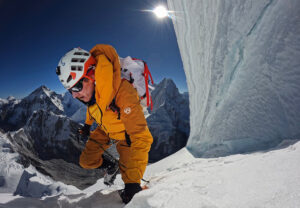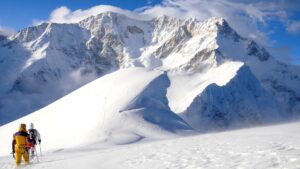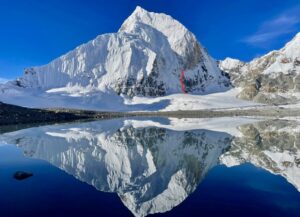In Nepal, there are 86 peaks (including sub-peaks) between 7,000m and 7,999m. Some of them haven’t been climbed for years. Today, we examine the climbing history of 7,227m Langtang Lirung.
Langtang Lirung
Langtang Lirung lies on the border of Tibet, in the Langtang Himal subrange of the Himalaya, southwest of Shishapangma.
Of the region’s 14 main peaks, only one is lower than 6,000m, 11 are between 6,000m and 6,999m, and two are higher than 7,000m: 7,205m Langtang Ri, and 7,227m Langtang Lirung.

Photo: Braulio Barahona
Langtang National Park, established in 1976, was Nepal’s first Himalayan national park and the fourth protected area in the country. It includes 26 villages plus the Langtang Valley. In the north and east, it connects with Qomolangma National Nature Preserve in Tibet. The Bhote Koshi and Trishuli Rivers link west and east, and the southern border is about 30km north of Kathmandu Valley.
A difficult, dangerous mountain
Langtang Lirung’s statistics suggest that it is a difficult, dangerous mountain, and few alpinists visit it. According to The Himalayan Database, 51 teams have attempted the summit, but only 14 succeeded. The last successful ascent was in the autumn of 2010.
In those 14 teams, a total of 54 climbers have stood on the top, and there have been 16 deaths. Three of those who died summited first. Avalanches were the primary cause of death (13 victims), falling rock/ice killed two people, and one climber fell and later died. The most recent fatality was the celebrated Tomaz Humar in 2009.
Commercial teams don’t go to this kind of mountain, and none of those attempting Langtang Lirung used bottled oxygen.

Langtang Valley and the trekking route. Photo: Base Camp Adventure
The first approach
In 1949, Bill Tilman and Peter Lloyd made an exploratory journey to the region, as covered in our story on Yangra Kangri.
According to Jill Neate in High Asia: An Illustrated History of the 7,000-Meter Peaks, the British climbers first traveled along the south flank of Langtang Lirung. They noted that a great cirque defended the south side of the mountain. They considered it impregnable. Accompanied by Tenzing Sherpa, Tilman went up the Lirung Glacier but only reached a subsidiary ridge. Beyond it lay a high glacier and the frontier ridge.
Tilman and Lloyd then tried to access Langtang Lirung from the north along the Tibetan border. But they got lost and accidentally entered Tibet before an official sent them back to Nepal.
Ten years later, in the autumn of 1959, a Japanese party led by Tetsuo Yamada targeted Langtang Lirung from the southeast side. But the team didn’t make much headway because they couldn’t find a feasible route. Instead, they made the first ascent of 6,707m Salbachum (also known as Phrul Rangtshan Ri) to the east of Langtang Lirung.

Sunrise on Langtang Lirung from Lirung Valley. Photo: Summitpost
First attempts
In the spring of 1961, another Japanese party tried Langtang Lirung. Six alpinists from the Osaka City University team, led by Kaichi Morimoto, targeted the mountain via the Langtang Glacier and the east ridge.
The team reached 6,450m, but an avalanche hit the group on May 11. It killed leader Morimoto, along with Kenji Oshima and Indian Gyaltsen Norbu Sherpa. The party abandoned their attempt.
Two years later, in the autumn of 1963, a 10-man Italian party led by Lino Andreotti made another attempt by the east ridge. On the evening of October 16, the weather was cloudy but very warm, and the snow didn’t harden. The team reached 6,000m but avalanches started the following morning. On October 17 at 8 pm, an avalanche swept away two team members, Giorgio Rossi and the team’s young doctor, Cesare Volante.
Rossi died immediately, his head destroyed by a rock, and Volante died two days later at base camp. In his trip report for The Himalayan Database, Andreotti wrote drolly that “Langtang (Lirung) is impossible to climb at this time because of avalanches, great crevasses, and glaciers, but exploration [was] successful…no incidents except fatal accident. No plans to return to the Himalaya, but very charming.”

Langtang Lirung. Photo: John C. Sill
A team from Osaka City University return
In April 1964, Takeo Suzuki led another team from Osaka City University (OCU) to the mountain. They arrived at base camp on April 4 and attempted the south ridge. They reported a lot of avalanches.
Two Japanese climbers and two sherpas reached 6,000m but had to turn around because of a difficult knife-edge ridge and avalanche danger. The leader’s trip report states that “Langtang (Lirung) probably cannot be climbed from the Nepal side. I don’t know whether OCU will try it again.”
Another attempt in 1964
On September 27, 1964, a British-Australian team led by Peter Taylor arrived. The party chose the southwest ridge but abandoned their climb at 6,700m because of the route’s difficulty.

On April 25, 2015, a 7.8-magnitude earthquake struck Langtang Lirung. In Langtang village, a landslide killed 243 people. Photo: EFE
The first ascent: 1978
In the autumn of 1978, Akira Ban, a member of the 1964 Japanese team, returned with an Osaka City University team including two strong, new members from Tribhuvan University. The party approached via the Langtang Glacier and targeted the east ridge. Three climbing sherpas accompanied them.
On October 15, the Japanese party made Camp 2 at 5,710m. Four days later, they made Camp 3 at 6,280m. Pushing slowly higher, they established Camp 4 on October 22 on the southeast glacier at 6,800m. From there, they started their summit push.
Two climbers reached the summit: Seishi Wada at 9:25 am and Pemba Tsering Sherpa two minutes later.

Langtang Lirung is notable for its huge vertical relief. Photo: BP Karma
Winter ascents and routes
On Jan. 3, 1988, Polish climbers Mikolaj Czyzewski, Kazimierz Kiszka, and Adam Potoczek completed the first winter ascent. They climbed via the southeast ridge. Nine more climbers have topped out in winter since then, most recently in 1994.
The most common route is the southeast ridge, followed by the southwest ridge.
The south face
There have only been a few attempts on the south face. In the spring of 1980, a British-Canadian party led by Michael Searle reached 5,600m but had to give up because of bad weather and gear issues. Their route followed a series of snow and ice gullies, a rib, and airy rock buttresses before the steep ice arete which leads to the summit 900m above. Avalanches were a constant threat.
In the spring of 1984, a Canadian party led by Shaun Parent attempted the same route but could only reach 6,340m in heavy snow.
In October-November of 2009, renowned Slovenian alpinist Tomaz Humar lost his life attempting to ascend the south face of Langtang Lirung. Humar fell and then froze to death, unable to move down because of his injuries.
An Iranian team led by Arash Ghiasian finally climbed the south face in the autumn of 2010.

The south face of Langtang Lirung. Photo: Michael Searle
Attempts from the north
There were also a few important attempts from the north. In the autumn of 1984, American Daniel Newell’s team tried via the northeast buttress. They reached 5,030m but could not continue because of inadequate equipment and funds. One year later, Newell again attempted the northeast buttress. The team got no higher than the previous year, and the expedition was called off when three members of the party died in an avalanche, including Newell.
East face attempts
Langtang Lirung is dangerous on every face and ridge because of avalanches. On some occasions, they even hit base camp.
The most difficult face is the east face, yet there have been some attempts. In the autumn of 2010, a Japanese team led by Hiroyoshi Manome made it to 4,150m.
In 2017, Antoine Girard and Julien Dusserre approached the east face by paraglider, but they could not ascend because of the dangerous conditions.
The last attempt to ascend the east face was last year, when three Ecuadorian climbers, Esteban “Topo” Mena, Joshua Jarrin, and Roberto Morales, gave up at 5,800m because of rockfall.

The east face of Langtang Lirung from above Kyanjing Gompa. The northeast ridge is on the right and the southeast ridge is on the left. Photo taken in March 1991. Photo: Summitpost






